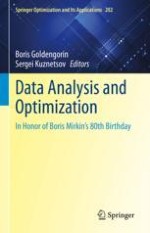2023 | OriginalPaper | Buchkapitel
About Some Clustering Algorithms in Evidence Theory
verfasst von : Alexander Lepskiy
Erschienen in: Data Analysis and Optimization
Verlag: Springer Nature Switzerland
Aktivieren Sie unsere intelligente Suche, um passende Fachinhalte oder Patente zu finden.
Wählen Sie Textabschnitte aus um mit Künstlicher Intelligenz passenden Patente zu finden. powered by
Markieren Sie Textabschnitte, um KI-gestützt weitere passende Inhalte zu finden. powered by
